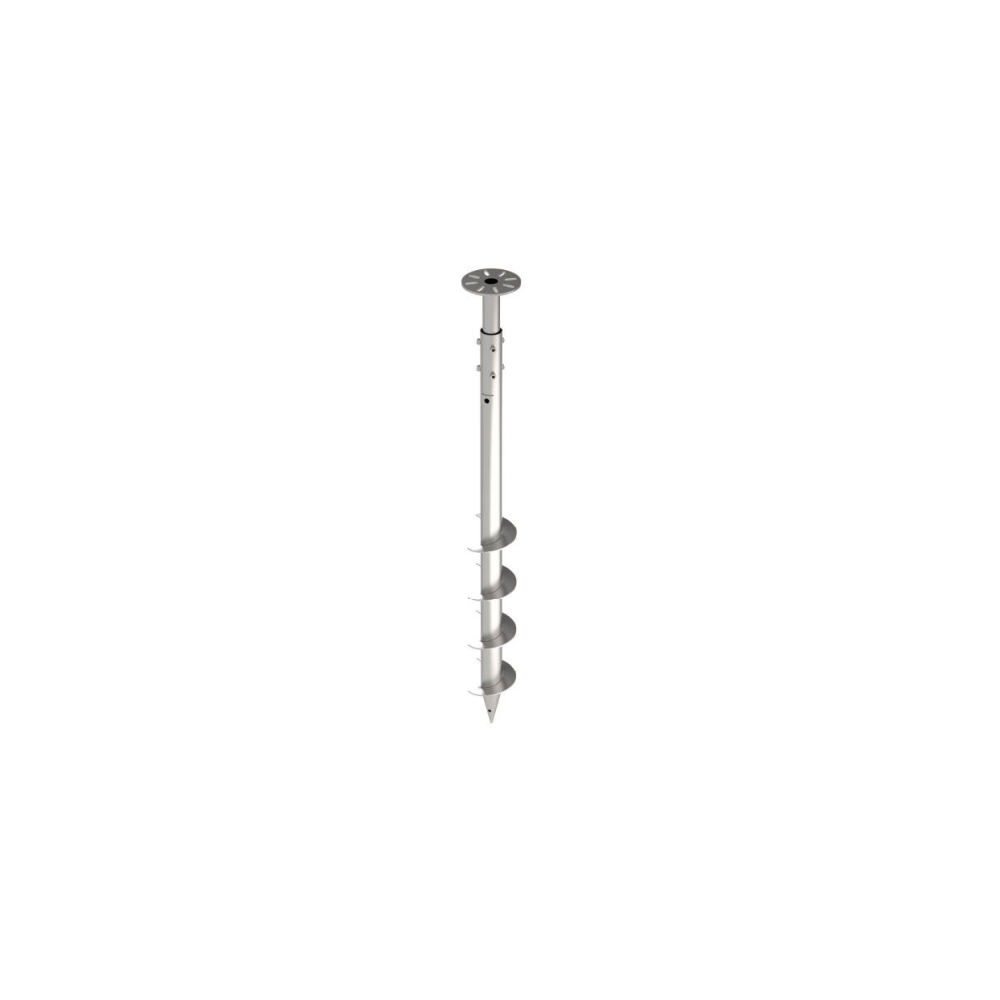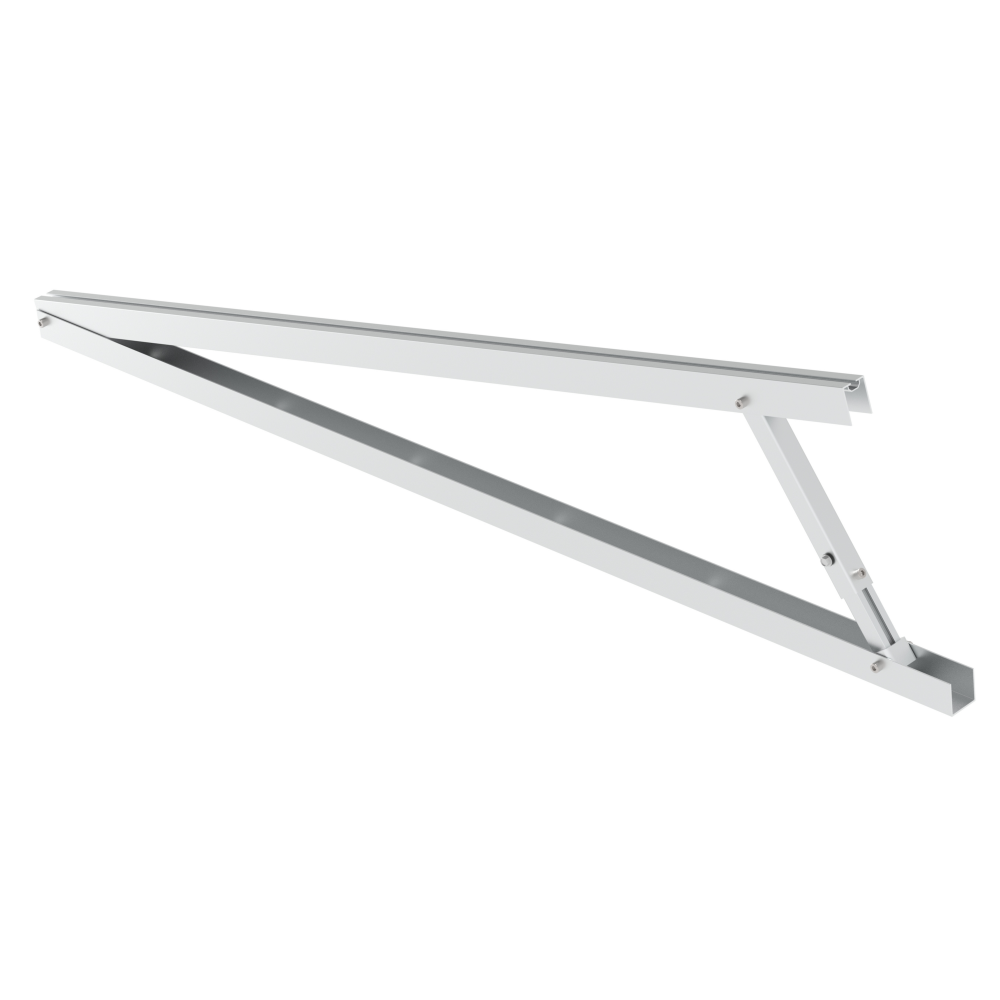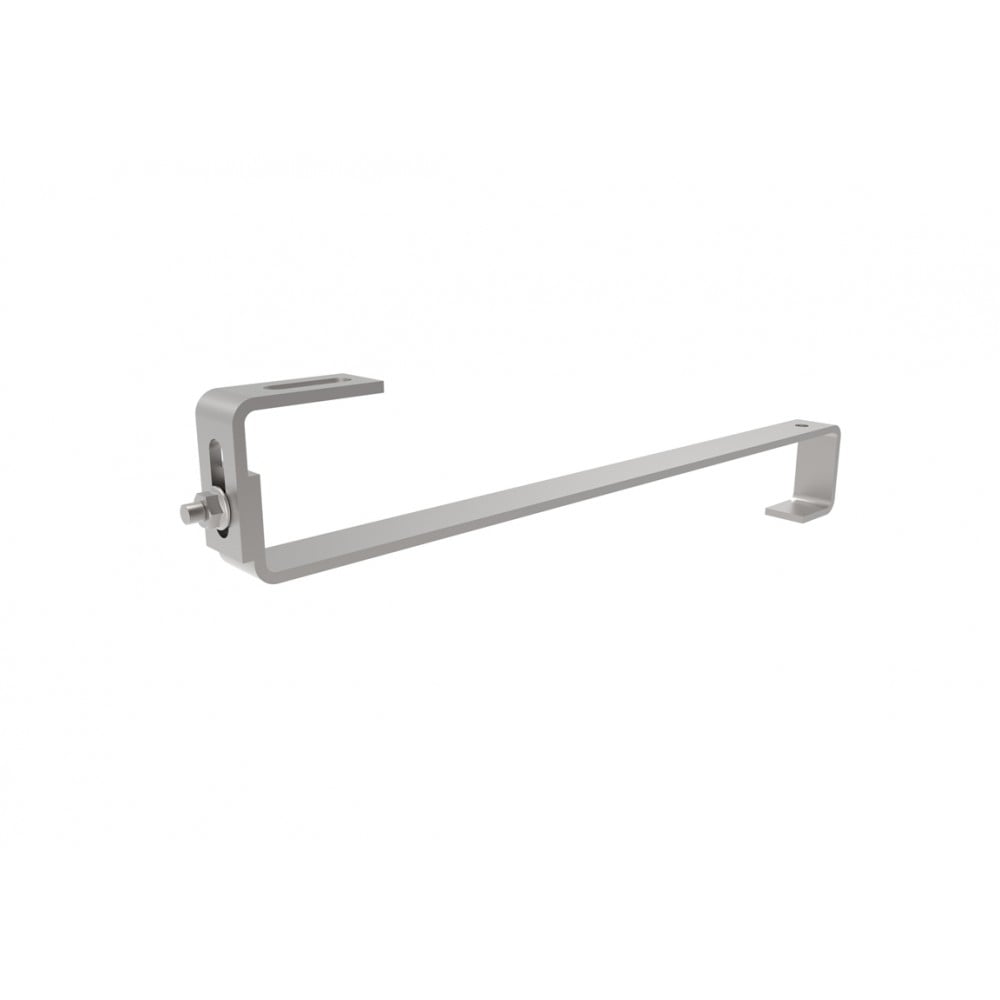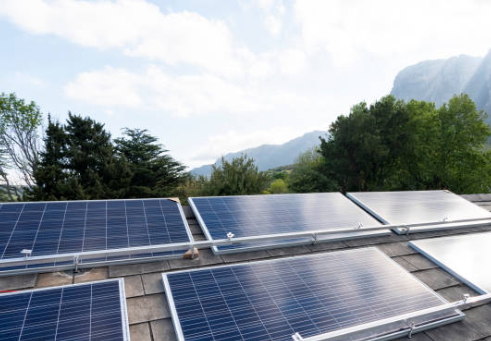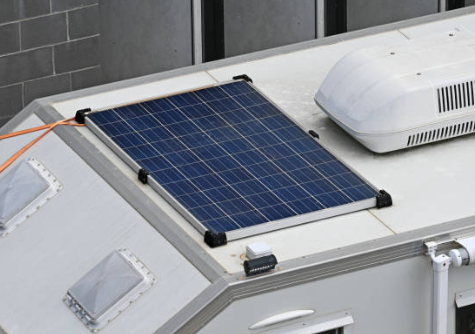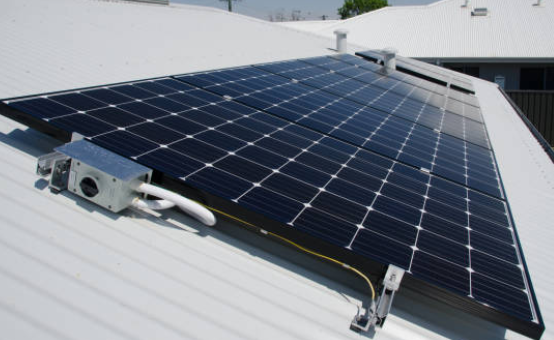News
The Benefits of a Ground Mounting System for Solar Panels
Introduction
One of the most important decisions when installing solar panels is choosing the right mounting system. Ground mounting systems are a popular choice due to their many benefits. In this article, we will explore the different aspects of a ground mounting system.
Design and Installation
Ground mounting systems can be designed to fit any terrain and soil type. They are installed by digging holes and securing the mounting structure with cement and steel poles. The panels are then attached to the mounting structure. Ground mounting systems require less preparation than roof-mounted systems, and the installation process is usually faster.
Accessibility and Maintenance
A ground mounting system allows for easy access to the solar panels for maintenance and cleaning. The absence of a roof structure makes it easy to reach all parts of the panel for inspection and maintenance. This accessibility contributes to a longer lifespan of the solar panels.
Optimal Performance
A ground mounting system is designed to optimize the performance of the solar panels. The panels are installed at an optimal angle and orientation to maximize the amount of sunlight they receive throughout the day. This translates to better energy production and efficiency.
Cost-Effective
Ground mounting systems are often more cost-effective than roof-mounted systems. They require less preparation and materials, which translates to lower installation costs. Additionally, ground mounting systems have higher energy outputs, which leads to a quicker return on investment.
Scalability
Ground mounting systems can be easily scaled to fit any energy needs. From small residential homes to large commercial buildings, a ground mounting system can be designed to provide the necessary amount of energy. Additionally, ground mounting systems allow for the addition of more solar panels in the future, making them a flexible and scalable option.
Flexibility in Placement
Ground mounting systems offer flexibility in terms of placement. They can be installed in any location with sufficient space, including fields, backyards, and parking lots. This flexibility allows for the placement of the solar panels in the most optimal location for energy production.
Aesthetics
Ground mounting systems can be designed to be visually appealing and blend in with the environment. The mounting structures can be made using a variety of materials, and the panels themselves can be black or blue. This flexibility in design allows for the panels to fit seamlessly into the surrounding environment.
Safety
Ground mounting systems are a safe option for solar panel installation. They are designed to withstand extreme weather conditions, such as high winds and heavy snow. Additionally, a ground mounting system eliminates the risk of roof damage, which can occur during roof-mounted installations.
Environmental Impact
Ground mounting systems have a minimal environmental impact. They do not require any roof penetration, which eliminates any potential roof damage. Additionally, the panels themselves are environmentally friendly, as they produce clean energy without emitting any harmful pollutants.
Conclusion
Ground mounting systems are a popular choice for solar panel installations due to their many benefits. From cost-effectiveness to aesthetics, a ground mounting system is a flexible option that can be designed to fit any energy needs. Its accessibility, scalability, and environmental benefits make it a smart choice for any solar panel installation.
Quote InquiryContact Us Now!
What is the Best Way to Mount Your Solar Panel?
The Importance of Properly Mounting Your Solar Panel
Solar panels are a great option for those looking to save money on their energy bills while reducing their carbon footprint. However, it’s important to properly install and mount your solar panel to ensure optimal energy production and to make sure it’s securely anchored. Here’s what you need to know about the best way to mount your solar panel.
Choose the Right Mounting System for Your Solar Panel
When it comes to mounting your solar panel, it’s important to choose the right type of mounting system. The two most common types are roof-mounted and ground-mounted systems. Roof-mounted systems generally use a simple rack that attaches to the roof, while ground-mounted systems require concrete footings to hold the arrays in place.
Consider the Angle and Direction of Your Solar Panels
Another important factor to consider when mounting your solar panels is the angle and direction. The best angle and direction for solar panels will depend on your location. For example, in the northern hemisphere, solar panels should face true south and be tilted at an angle equal to your latitude plus 15 degrees.
Ensure Proper Ventilation for Your Solar Panels
Proper ventilation is important to ensure that your solar panels don’t overheat. Make sure there is a gap between the solar panel and the mounting surface to allow air to flow freely and help keep the panel cool.
Choose the Right Mounting Hardware
Choosing the right mounting hardware is crucial to ensure that your solar panel is securely anchored. Use high-quality bolts, screws, and clamps to ensure the mounting system is strong enough to hold your solar panel in place, even in high wind conditions.
Properly Ground Your Solar Panel
Proper grounding of your solar panel is essential for safety reasons. Grounding your solar panel helps to protect against electrical shock in the event of a lightning strike or other electrical event.
Consider the Weight of Your Solar Panel
Solar panels can be quite heavy, so it’s important to make sure that the mounting system can support the weight of the panel. Always follow manufacturer’s guidelines for the appropriate amount of weight your mounting system can handle.
Check Your Local Building Codes
Before installing your solar panels, make sure to check your local building codes. Regulations can vary by location and can impact the design and installation of your solar panel mounting system.
Regularly Inspect Your Solar Panel Mounting System
Once your solar panel is installed, be sure to regularly inspect the mounting system for any signs of damage or wear and tear. Regular maintenance will help ensure that your solar panel is securely anchored and producing optimal energy output.
Work with a Professional Solar Panel Installer
If you’re not comfortable installing your solar panels yourself, it’s best to work with a professional solar panel installer. They will have the necessary expertise and equipment to properly install and mount your solar panel.
solar panel mounting, roof-mounted systems, ground-mounted systems, angle and direction, ventilation, mounting hardware, grounding, local building codes, inspection, professional installation
What is the best way to mount your solar panel?? Tips and Tricks
Proper mounting is essential for optimal energy production and safety. Learn what you need to know about installing your solar panels.
- What is the best type of mounting system for solar panels?
- What angle should solar panels be mounted at for optimal energy output?
- What type of mounting hardware should be used for solar panels?
- How do I properly ground my solar panel?
- What should I consider before mounting my solar panel?
- How do I ensure proper ventilation for my solar panel?
- How often should I inspect my solar panel mounting system?
- Can I install my solar panels myself or should I work with a professional?
- What should I know about local building codes when installing solar panels?
- How much weight can my solar panel mounting system handle?
Quote InquiryContact Us Now!
How Many Roof Hooks per Solar Panel? Important Considerations to Keep in Mind
Introduction
If you are looking to install solar panels on your roof, you might be wondering how many roof hooks you will need per panel. But unfortunately, there isn't a one-size-fits-all answer to this question. The answer depends on a number of different factors. In this article, we'll explore some of the most important considerations that you need to keep in mind when determining how many roof hooks you'll need for your solar panel installation.
The Weight and Size of your Solar Panel
The weight and size of your solar panel will play a big role in determining how many roof hooks you need. This is because the more panels you have, the more support you will need to keep them in place. Larger panels will also require more hooks than smaller ones. Be sure to check the weight and size specifications for your particular panels to determine how many hooks you need.
The Pitch and Orientation of your Roof
The pitch and orientation of your roof will also be important considerations when determining how many roof hooks you'll need. For example, if you have a steeply pitched roof, you'll need more support to keep the panels in place. Similarly, if your roof faces in a direction that gets a lot of wind, you'll need more hooks to keep the panels from getting blown away.
The Type of Roof You Have
The type of roof you have will also impact the number of roof hooks you need. Different materials require different types of hooks, and some materials may require more support than others. For example, if you have a tile roof, you may need more hooks than if you have an asphalt or metal roof.
The Location of the Roof Hooks
The location of the roof hooks will also impact how many you need. If the hooks are spaced too far apart, the panels may sag or become twisted, which can impact their energy output. Be sure to follow the manufacturer's recommendations for the placement and spacing of the hooks to ensure that your panels are properly supported.
The Load-Bearing Capacity of Your Roof
Another important consideration when determining how many roof hooks you need is the load-bearing capacity of your roof. If you install too many hooks, you could end up damaging your roof and compromising its ability to support the panels. It's important to have a professional assess your roof's load-bearing capacity before installing solar panels.
The Cost of Additional Hooks
While you want to ensure that your solar panels are properly supported, you also don't want to overspend on extra roof hooks that you don't really need. Be sure to weigh the cost of additional hooks against the benefits they provide to determine if they're really necessary.
The Climate in Your Area
The climate in your area will also impact how many roof hooks you need. If you live in an area that gets a lot of snow or rain, you may need additional hooks to keep the panels in place and prevent damage. Similarly, if you live in an area with high winds, you'll need more support to keep the panels from being blown away.
The Strength of Your Solar Panel Racking System
The strength of your solar panel racking system will also impact how many roof hooks you need. If you have a weak racking system, you may need additional hooks to properly support the weight of the panels. Be sure to choose a strong and reliable racking system that's designed to handle the weight of your solar panels.
The Experience of Your Solar Panel Installer
The experience of your solar panel installer is also an important consideration when determining how many roof hooks you need. An experienced installer will know how to properly assess your roof's load-bearing capacity and determine the optimal placement and spacing of the roof hooks to ensure that your panels are properly supported.
Conclusion
So, how many roof hooks do you need per solar panel? The answer depends on a variety of factors, including the weight and size of your panels, the pitch and orientation of your roof, the type of roof you have, the location of the hooks, the load-bearing capacity of your roof, the cost of additional hooks, the climate in your area, the strength of your racking system, and the experience of your installer. By keeping these factors in mind and consulting with a professional, you can ensure that your solar panels are properly supported and will provide you with years of clean energy.
Quote InquiryContact Us Now!
Solar Roof Brackets: Everything you need to know
The Importance of Solar Roof Brackets
Solar roof brackets are an essential component of any solar panel installation. These brackets serve as the foundation for the panels, providing stability and support. They can be mounted on a variety of roof types, including metal and shingle roofs. By utilizing solar roof brackets, homeowners can take advantage of the sun's energy to power their homes and reduce their carbon footprint.
Different Types of Solar Roof Brackets
There are two main types of solar roof brackets: flush mounts and tilt mounts. Flush mounts are ideal for flat roofs, as they provide a sleek and aerodynamic look. Tilt mounts, on the other hand, are more versatile and can be adjusted to maximize solar energy production. They are ideal for roofs with a slope of up to 45 degrees.
The Installation Process
The installation process for solar roof brackets varies depending on the type of bracket being used and the roof type. In general, the process begins by measuring and marking the placement of the brackets on the roof. The brackets are then attached to the roof using screws or bolts. Once the brackets are firmly in place, the solar panels are attached to the brackets using mounting hardware.
The Benefits of Solar Roof Brackets
By using solar roof brackets, homeowners can enjoy a number of benefits. First and foremost, they can significantly reduce their energy bills by generating their own electricity. Additionally, solar panels can increase the value of a home and reduce its carbon footprint. Solar panels are also environmentally friendly, as they generate clean energy without the use of fossil fuels.
The Durability of Solar Roof Brackets
Solar roof brackets are built to last. They are typically made of durable materials, such as stainless steel or aluminum, that can withstand harsh weather conditions. Additionally, they are designed to hold up against the weight of the solar panels and the winds they may be exposed to.
The Cost of Solar Roof Brackets
The cost of solar roof brackets varies depending on the type of bracket being used, the number of brackets needed, and the installation process. However, in general, solar roof brackets are a relatively inexpensive component of a solar panel system.
Maintaining Your Solar Roof Brackets
To ensure the longevity and effectiveness of your solar panel system, you should perform routine maintenance on your solar roof brackets. This includes checking for any signs of wear or damage, tightening screws and bolts, and cleaning the brackets and panels to remove any debris.
Choosing the Right Solar Roof Brackets
Choosing the right solar roof brackets is crucial for the success of your solar panel system. Consider the type of roof you have, the slope of your roof, and your energy needs when selecting the appropriate brackets.
The Future of Solar Roof Brackets
As the demand for clean energy sources continues to grow, the use of solar roof brackets is expected to increase. Innovations in solar panel technology and installation methods are likely to make solar energy even more accessible and affordable for homeowners.
The Bottom Line
Solar roof brackets are a critical component of any solar panel system. They provide stability and support for the panels, allowing homeowners to harness the power of the sun to generate their own electricity. By choosing the right type of solar roof bracket and performing routine maintenance, homeowners can enjoy the benefits of clean, renewable energy for years to come.
Solar Panel Clamps: Everything You Need to Know
Introduction
Solar panel installation is a great way to reduce energy costs and contribute to a sustainable environment. However, it's important to secure the panels properly, and that's where Solar Panel Clamps come in. In this article, we'll cover the basics of solar clamps, how they work, and the different types
What are solar panel clamps?
Solar panel clamps are essential components in solar panel installation. These clamps secure the solar panels to a mounting system that anchors them to the rooftop. The clamps come in different shapes, sizes, and materials to hold the solar panels firmly in place.
How do they work?
Solar panel clamps work by attaching the solar panel to the mounting system on the rooftop. The clamps are placed on the edges of the panels and slide into the mounting rails. Once in place, the clamps lock onto the rail, securing the solar panel to the mounting system. The clamps also adjust to accommodate different panel thicknesses.
Types of solar panel clamps
There are two main types of solar panel clamps: end clamps and mid clamps. End clamps are installed at the end of the solar panel, while mid clamps are used in between the panels. End clamps are designed to attach the panel to the mounting rail at the panel's edge, while mid clamps join two panels together and attach them to the rails. Both end and mid clamps come in different sizes to fit different panel widths and thicknesses
Materials used for solar panel clamps
Solar panel clamps are made from different materials, including aluminum, stainless steel, and plastic. Aluminum is the most common material used because of its strength and durability. Stainless steel is also a great option because it's corrosion-resistant and long-lasting. Plastic clamps are less expensive and easy to install but may not be able to withstand extreme weather conditions.
Importance of using high-quality clamps
Using high-quality solar panel clamps is crucial for a successful, robust solar panel system. Cheap, low-quality clamps can deteriorate quickly, leading to system failure. High-quality clamps can withstand extreme temperatures, moisture, and other weather conditions. They also keep the panels securely in place, preventing them from flying off in strong winds, which can cause damage to the panels and surrounding structures.
Key features to look for when buying solar panel clamps
There are several key features to look for when buying solar panel clamps:
The size of the clamps, which should match the size of the panels and the mounting rail
The material used to manufacture the clamps, ensuring they are strong and durable
The compatibility of the clamps with different rails and panels to ensure they fit securely
Installation process
The installation process for solar panel clamps is relatively straightforward. First, the mounting system should be installed on the rooftop. Then, the clamps are inserted into the mounting rails and onto the solar panels. The clamps are locked into place, ensuring the panels are securely attached to the mounting system.
Maintenance and inspection of solar panel clamps
Regular maintenance and inspections are vital to ensure the solar panel system is working correctly and is safe. Solar panel clamps should be checked regularly for any signs of wear and tear. Any damaged or faulty clamps should be replaced immediately. Regular maintenance will ensure the solar panels are securely attached and prevent system failure.
Conclusion
Solar panel clamps are vital components of a solar panel system. They secure the panels to the mounting system, ensuring the panels remain stable and secure. Understanding the types, materials, and installation process of solar panel clamps is essential to achieve a successful solar panel system. Choosing high-quality clamps and maintaining them properly will ensure the longevity and safety of the entire system.
Quote InquiryContact us
The Advantages of Using Solar Roof Hooks for Installing Solar Panels
What Is a Solar Roof Hook?
A solar roof hook is a device that helps mount solar panels onto roofs. It is typically made of aluminum or stainless steel and comes in various shapes and sizes to accommodate different roofing types. The hook is installed onto the roof and serves as an anchor for the solar panel railings.
Why Use Solar Roof Hooks?
Using solar roof hooks to install solar panels offers several advantages. First, it is a cost-effective solution because it does not require drilling into the roof and making substantial modifications. Second, it is a quick and easy installation process that does not cause significant disruptions to the household or business. Third, using solar roof hooks ensures that the panels are securely fastened to the roof, providing peace of mind and preventing possible damage or injury.
Types of Solar Roof Hooks
Several types of solar roof hooks are available on the market. Some are designed for shingle roofs, whereas others are made for metal roofs. Some are compatible with flat roofs, while others are for pitched roofs. It is essential to choose the right type of solar roof hook that fits the roofing material and type to ensure a secure installation.
Installation Process
The installation process for solar roof hooks is relatively straightforward. After positioning the hooks in the right place, they are screwed onto the roof. Solar panel railings are then attached to the hooks, which serve as the anchor point. It is essential to make sure the hooks are securely attached to the roof to minimize the risk of damage or accidents.
Load Capacity
Before installing solar panels using roof hooks, it is crucial to know the load capacity of the roof. The load capacity refers to the amount of weight that the roof can support. Different types of roofs have different load limits, and it is essential to have this information to ensure that the panels and mounting equipment do not exceed the capacity and cause damage.
Maintenance
Maintaining solar roof hooks is critical to ensure that the installation remains stable and secure. It is essential to inspect the hooks periodically and adjust or replace them if they become loose or damaged. Regular cleaning of the panels and hooks is also crucial to ensure optimal energy output.
Cost
The cost of using solar roof hooks for installing solar panels varies depending on various factors such as the type of roofing material, roof size, and load capacity. However, compared to other installation methods, using roof hooks is an affordable option that provides value for money.
Environmental Benefits
One of the significant benefits of using solar roof hooks for installing solar panels is the environmental impact. By using clean, renewable energy, solar panels can help reduce dependence on fossil fuels and greenhouse gas emissions. This contributes to a cleaner, more sustainable planet and helps combat climate change.
Warranty and Guarantee
When choosing a solar roof hook, it is crucial to ensure that it comes with a warranty and guarantee. This provides peace of mind that the product is of high quality and that any issues that arise will be covered. It is essential to read the terms and conditions carefully and understand what is covered under the warranty and how to make a claim if necessary.
Conclusion
Solar roof hooks are an excellent option for installing solar panels onto roofs. They are cost-effective, easy to install, and provide reliable, secure anchorage for solar panel railings. By using solar roof hooks, households and businesses can take advantage of clean, renewable energy, and contribute to a sustainable, healthier planet.
Quote InquiryContact us
What Color Metal Roof is Best for Solar Panels?
Introduction
Many homeowners choose metal roofs for solar panel installation. Metal roofs have a long lifespan and are energy efficient. The color of a metal roof may also have an impact on the efficiency of solar panels.
This article will discuss the most suitable roof colors for solar panels when installing metal roofs.
Related Topics You May Also be Interested:
What Angle Roof is Best for Solar Storgae
How to Choose the Right Mounting System for Solar Panels
Guide to Portable Solar Panels on the Roof
How Different Roof Colors Affect the Solar Energy Storage
1. The light colors reflect more heat
Heat reflection is a key factor to consider in choosing the right color for your solar panel roof. White or light grey metal roofs reflect more heat than dark colors. The roof will absorb less heat, which means lower energy bills and better solar panel performance. If energy efficiency is important to you, choose metal roofs with light colors.
2. The White Metal Roof and the Solar Panel Efficiency
Due to their high reflectiveness, white metal roofs are ideal for installing solar panels. White roofs reflect more light, allowing solar panels to be more efficient. The white metal roofs reflect 90% of sunlight. This reduces the amount of heat that builds up on the roof, and improves overall energy efficiency.
3. The Light Gray Roof and the Solar Panel Performance
A light gray metal roof is another great choice. They may not be as reflective as white metal roofs but they can still help to maintain a cool roof temperature. A cooler roof will improve the performance of solar panels and reduce heat damage. Metal roofs in light gray also give a modern and sleek appearance.
4. Cool Roofs for Energy Savings
The term "cool roof" refers to roofing material that reflects more sunlight while absorbing less heat. The energy consumption of air conditioners can be reduced by these roofs. Solar panels installed on cool metal roofing can improve the energy efficiency of your house.
Tips: The Darker the Color, the More Effective Solar Panels
Darker colors like black and dark brown can be a good alternative to light colored metal roofs. While dark-colored roofs can absorb more heat than lighter ones, they also retain heat during the colder months. Using highly efficient solar panels can also reduce the effect of dark-colored roofs on panel efficiency.
Other Factors to Consider for Metal Roof Solar Mountin
Climate Change: What it Means for You
Consider your climate when choosing the color for your solar panel roof. Lighter-colored metal roofs work better in hotter climates where the cost of cooling is a major concern. In colder climates darker colored roofs will help retain heat. The balance must be struck between climate-suitability and energy efficiency.
Aesthetic Aspect
The color of the metal roof can also affect the aesthetic appeal of the home. Dark-colored metal roofs have a sophisticated and classic look, while light-colored ones tend to be more contemporary and cleaner. When choosing the color of your metal roof, consider your own personal tastes and architectural style.
Solar Panels with Roof Colour Contrast
Consider the contrast of the metal roofing and solar panels. Black solar panels will create a striking contrast with a lighter-colored metal roof. If you opt for a darker roof color, then lighter panels will create a pleasing visual effect. Solar panels can be more visible and attractive if they are contrasted.
Bonus: Maintenance and durability
The maintenance and durability is another factor. The light-colored metal roofs are more likely to reveal dirt and other debris, which means they need more cleaning. Roofs with dark colors can conceal dirt and stains more effectively, but they may also fade over time. Consider the durability and maintenance of your roof when choosing a color.
Consult a professional for advice
If you are unsure about what color to choose for your roof, we recommend consulting a professional. Solar panel experts can offer valuable insight based on the needs of your home, its design and climate. This will help you to make an educated decision.
Request for a Quote
Get all ROOF MOUNTING SOLUTIONS RIGHT HERE
The conclusion of the Metal Roof for PV Energy
It is important to choose the correct color of your roof metal when you install solar panels. This will maximize energy efficiency. Roofs with lighter colors, like white and light gray reflect heat better, making them ideal in warmer climates. Darker colors are still viable, particularly when combined with solar panels that provide high efficiency. Take into account your personal preferences and climate when making a decision on the metal pv mounting.
Can You Put Portable Solar Panels on the Roof: Exploring the Feasibility and Benefits
1. Understanding the Viability of Installing Portable Solar Panels on the Roof
As renewable energy sources gain popularity, many homeowners are considering the feasibility of putting portable solar panels on their roofs. This article aims to provide insights into the practicality, benefits, and potential challenges associated with this idea.
2. Benefits of Utilizing Portable Solar Panels on Your Roof
Portable solar panels offer several advantages, including reduced energy bills, independence from the grid, and environmental sustainability. By harnessing the sun's energy, you can generate clean electricity and contribute to reducing greenhouse gas emissions, thereby promoting a greener future.
3. Assessing the Roof Structure for Solar Panel Installation
Before installing portable solar panels on your roof, it is crucial to evaluate the structural integrity and suitability of your roof. Factors such as roof orientation, slope, and shading from nearby trees or buildings can affect the efficiency of your solar panels. Consulting a professional can help determine if your roof is suitable for solar panel installation.
4. Understanding the Installation Process
The installation process for portable solar panels on your roof typically involves mounting the panels securely, connecting them to an inverter, and integrating them with your electrical system. It is essential to hire certified professionals or consult manufacturers' guidelines to ensure a safe and efficient installation.
5. Maximizing Energy Production with Proper Roof Placement
Proper placement of portable solar panels on your roof is crucial for optimal energy production. South-facing roofs generally receive the most sunlight throughout the day, maximizing the panels' efficiency. However, east and west-facing roofs can also be viable options, depending on your location and energy needs.
6. Overcoming Potential Challenges
While portable solar panels offer flexibility, there are potential challenges to consider. Limited roof space, shading from surrounding structures, and local regulations can impact the installation and performance of your solar panels. Adequate planning and professional advice can help you overcome these challenges.
7. Ensuring Safety and Compliance
When installing portable solar panels on your roof, safety should be a top priority. Follow local building codes and regulations, ensuring that the installation meets all necessary standards. Additionally, it is crucial to secure the panels properly to prevent any risks associated with strong winds or adverse weather conditions.
8. Maintenance and Monitoring of Portable Solar Panels
Regular maintenance and monitoring are essential to ensure the longevity and optimal performance of your portable solar panels. Cleaning the panels, checking for any damage, and monitoring the energy production can help identify any issues early on and maximize the system's efficiency.
9. The Portability Advantage
One significant advantage of portable solar panels is their mobility. While they can be installed on your roof, you can also easily relocate them to other areas, such as camping sites or vacation homes. This flexibility allows you to enjoy the benefits of solar energy wherever you go.
10. Exploring the Cost and Return on Investment
Investing in portable solar panels for your roof involves initial costs, including the panels, installation, and potential upgrades to your electrical system. However, over time, the savings on energy bills and potential government incentives can offset the investment, resulting in a positive return on investment.
Quote InquiryGET ALL ROOF SOLAR MOUNTING SOLUTIONS HERE
What Angle Roof is Best for Solar? A Comprehensive Guide
The Importance of Roof Angle for Solar Panels
When it comes to installing solar panels on your roof, one crucial factor to consider is the angle at which they are mounted. The angle of your roof can significantly impact the energy production and efficiency of your solar system. In this article, we will explore the best roof angles for solar panels, taking into account various factors such as geographical location, seasonality, and tilt optimization. Read on to discover how to maximize your solar energy potential!
1. Optimal Roof Angles for Solar Panels
Choosing the right angle for your solar panels is essential to ensure maximum energy production. The optimal roof angle varies depending on your location's latitude. For instance, if you live closer to the equator, a lower roof tilt will capture more sunlight throughout the year. On the other hand, if you reside in higher latitudes, steeper roof angles are recommended to compensate for the reduced sunlight intensity.
2. Latitude and Roof Orientation
The latitude of your location plays a vital role in determining the ideal orientation of your solar panels. In the Northern Hemisphere, south-facing roofs receive the most sunlight, making them the preferred orientation for solar installations. Conversely, in the Southern Hemisphere, north-facing roofs are more advantageous. It is important to align your solar panels perpendicular to the sun's rays to maximize energy absorption.
3. Seasonal Adjustments for Maximum Efficiency
While optimizing your solar panel angle according to your location's latitude is beneficial, it is also crucial to consider the seasonal variations in sun position. Adjusting the tilt of your panels at different times of the year can significantly improve their efficiency. Many solar systems use adjustable mounting systems or tilting mechanisms that allow for easy seasonal adjustments, ensuring optimal energy production throughout the year.
4. The Influence of Roof Pitch
Aside from the latitude and orientation, the pitch or slope of your roof also affects solar panel performance. In general, roofs with a pitch between 15 and 40 degrees are considered ideal for solar installations. This range provides an optimal balance between capturing sunlight and minimizing dirt and debris accumulation. Flat roofs may require additional mounting systems to achieve the desired tilt angle.
5. Considerations for Winter Months
In regions with significant snowfall, it is crucial to consider the angle of your roof to prevent snow accumulation on your solar panels. A steeper roof angle helps snow slide off more easily, ensuring uninterrupted energy production during the winter months. However, it is essential to strike a balance between snow shedding and year-round efficiency, as excessively steep angles may reduce energy production during other seasons.
6. Impact of Shading on Roof Angle
Shading can significantly affect the performance of your solar panels. If your roof is partially shaded by trees, nearby buildings, or other obstructions, it is essential to consider the shadow patterns throughout the day and year. In such cases, adjusting the tilt and placement of solar panels can help mitigate the negative impact of shading, ensuring optimal energy production.
7. Rooftop Solar Panel Mounting Options
There are various mounting options available for rooftop solar panel installations, each with its own advantages and considerations. Fixed mounts, which are set at a specific angle, are the most common and cost-effective option. However, for homeowners seeking maximum energy production, adjustable mounts or tracking systems that follow the sun's path throughout the day may be worth considering. These options allow for precise alignment and enhanced efficiency.
8. Consulting with Solar Professionals
When determining the best roof angle for your solar panels, it is advisable to consult with experienced solar professionals. They can assess your specific location, roof structure, and shading conditions to provide personalized recommendations. Additionally, solar installers have access to advanced tools and software that can accurately calculate the optimal roof angle for your solar system, ensuring maximum energy generation.
9. Roof Angle and Return on Investment
Optimizing the angle of your roof for solar panels not only enhances energy production but also impacts the financial return on your investment. By maximizing the efficiency of your solar system, you can generate more electricity and save on your monthly utility bills. Additionally, a well-designed solar installation can increase the value of your property, making it a worthwhile long-term investment.
10. Conclusion
Choosing the best roof angle for your solar panels is a crucial decision that can significantly impact the performance and efficiency of your solar system. By considering factors such as latitude, roof orientation, seasonal adjustments, and shading, you can optimize your solar energy production. Consulting with solar professionals and using advanced tools will help you determine the ideal roof angle for your specific location, ensuring maximum return on investment and a sustainable energy future.
Quote InquiryGET ALL ROOF SOLAR MOUNTING SOLUTIONS HERE










